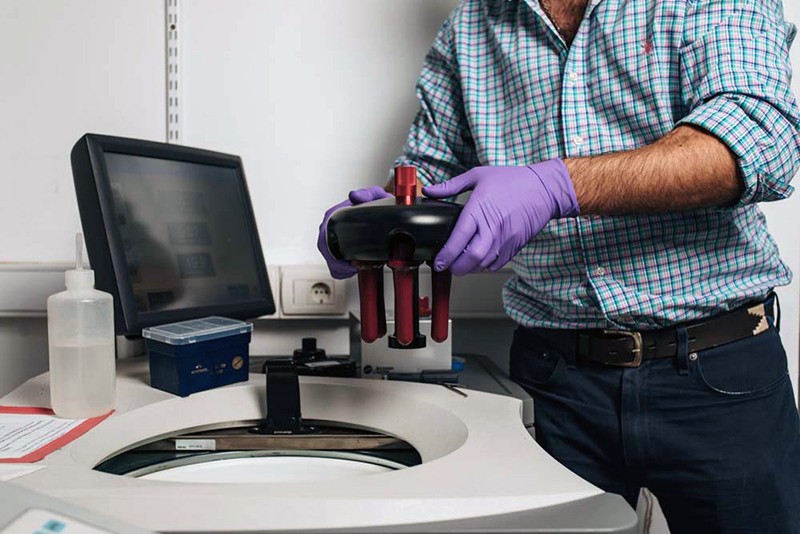A serendipitous finding led Juan Pablo Tosar to uncover the protein-making machinery outside cells — a discovery that has scientists rethinking fundamental assumptions.
If Juan Pablo Tosar hadn’t been so forgetful, he would never have stumbled across a finding that threatens to upend a basic tenet of cell biology. In 2016, two months after he was awarded his PhD, in a laboratory at the Pasteur Institute of Montevideo in Uruguay, Tosar was tasked with processing samples of breast cancer cells. The aim was to discard the cells and membrane-bound structures so that researchers could study just the molecules that existed in the fluid between cells. To separate out the unwanted components, Tosar had to spin the samples in a centrifuge. According to the standard protocol, he should have cooled the centrifuge’s removable rotor to 4 °C to protect the samples from degrading. “The correct way of doing that is putting it in the cold room the night before,” he says. “Sometimes I forgot, so it was not as cool at should be.” He still went ahead with the experiments, however. “I said, what’s the difference?” he recalls. “But there was.”
When Tosar cooled the rotor sufficiently, the results from the analysis showed a tiny peak indicating the presence of large RNA molecules in the extracellular space, where they were not expected to be. But when he forgot the cooling step, that small peak would disappear. The anomaly stirred his curiosity.
Tosar had an inkling that the explanation could be something big — quite literally. There are many types of RNA, and the biggest ones form ribosomes. These structures are essential apparatus that other kinds of RNA load onto to turn genetic code into proteins, and it is a basic tenet of biology that they function only inside cells. But what if these crucial protein factories were also floating around in the extracellular space? The data from Tosar’s accidentally too-warm centrifuge pointed to this possibility.
Trying to understand how things work and thinking outside the box has always been in Tosar’s nature. As a 14-year-old boy growing up in Uruguay, his hobby was to create computer games, such as a poker game in which the players could cheat by taking extra cards. But, one day, his parents took the computer to be repaired, and the person at the shop mistakenly erased all the data. The episode pained Tosar so much that he swore never to have a career in computer science, and ultimately turned to biology.
His career path eventually led him to the Pasteur Institute of Montevideo, where he met his mentor, biologist Alfonso Cayota. Cayota was trying to work out the part RNA plays in cell communication. RNA is best known for its role in helping cells turn their DNA blueprint into proteins through a process known as translation — within the confines of the cell membrane. But Cayota’s group was looking at extracellular RNA (exRNA), which exists outside the cell membrane. Growing evidence suggests that cells use exRNA to influence one another.
As a PhD student in Cayota’s lab, Tosar examined every kind of exRNA he could find. At the time, many researchers were focused on exRNA inside tiny membrane structures found throughout the body called extracellular vesicles (EVs). EVs — which include a small type known as exosomes — are released by cells into the extracellular space. But Cayota and Tosar took a different approach. They decided to investigate exRNA found outside these structures. In 2015, they and their colleagues reported that various types of exRNA existed independently of exosomes. The assortment included transfer RNA (tRNA) molecules, which are important for ferrying the amino-acid building blocks of proteins to the ribosomes. The researchers’ follow-up experiments showed that tRNAs could persist in a stable conformation outside both cells and exosomes.

Juan Pablo Tosar holds the centrifuge rotor he forgot to cool during his experiments | Credit: Sebastián Aguilar
It was around this time that Tosar had the curious results from the centrifuges that he had forgotten to cool. And he was determined to work out what was causing them. Finding it difficult to obtain essentials, such as certain reagents, in Uruguay, he secured a three-month stint to accelerate the work at the laboratory of Pavel Ivanov at the Brigham and Women’s Hospital in Boston, Massachusetts. He convinced his wife, a paediatrician, to uproot their life and move there with their toddler and three-month-old infant in the spring of 2019. For the next few months, Tosar attempted to confirm that the structures were in fact ribosomes.
To amplify the signal of ribosomal RNA, Tosar added compounds known as ribonuclease inhibitors to the samples, which block naturally occurring enzymes from digesting RNA. When he did so, the small peak of ribosomal RNA became huge. It suggested that ribosomal RNA exists in the extracellular space outside of vesicles, albeit fleetingly before the body’s natural enzymes get to work. His findings, which were posted on the preprint server bioRxiv in January3 and are under consideration for publication in a journal, also detail how these extracellular ribosomes are activated when mixed with the energy-carrying molecule ATP — suggesting that they have the potential to produce proteins outside cells.
“These are thought-provoking data,” says Esther Nolte-’t Hoen, whose lab at Utrecht University in the Netherlands studies extracellular signals. “The possibility that protein translation occurs outside cells may have been overlooked until now because cell-culture conditions are often not permissive for ribosomes to remain stable.”
“That the possibility exists is incredibly exciting,” Tosar says. The work is still preliminary, and needs to be replicated by other groups. But if proteins are synthesized in the space between cells, this would mean that cells have even more ways to communicate with each other than biologists thought. Drug makers could also take advantage of this phenomenon by delivering the genetic template for protein drugs directly to extracellular ribosomes. “Sometimes I feel like the great discoveries were made decades ago,” Tosar says, “but when you see stuff like this you feel like there’s a whole world to explore.”
Package deal
Pick up any biology textbook and you will find an account of the discovery of the structure of DNA in the 1950s, and how scientists worked out that certain kinds of RNA serve as a copy of that information. For many years, it was thought that all this genetic information was carried inside cells. But within a few decades, researchers began to challenge this simple view.
In 1983, a couple of years before Tosar was born, two papers were published describing the presence of tiny vesicles outside cells4,5. Soon after publication, the co-author of one of these seminal papers, biochemist Rose Johnstone, coined the term exosome. However, these discoveries faded into history, and it wasn’t until 1996, when researchers at Utrecht University discovered exosomes being churned out by immune cells6, that the field started to blossom.
But even then, some scientists pushed back against the suggestion that these vesicles contained RNA. Many simply refused to accept that living cells were systematically releasing genetic material. Jan Lötvall, who studies exosomes at the University of Gothenburg in Sweden, remembers the scepticism he faced when, in 2007, he reported that exosomes could shuttle RNA between cells7. He recalls that others scoffed at his suggestion that living cells not only release genetic material but also receive these packages from other cells. This sort of signalling between cells was a concept that people struggled to accept. Biologists knew about nerves pinging each other with electrical signals, and chemical messengers such as hormones triggering distant cells. But the idea that packages of nucleic acids were shared between cells suggested a whole new realm of cellular communication. “I lost grants when we published this,” Lötvall says. Funders were reluctant to support the follow-up experiments he proposed. Now, however, the paper has been referenced upwards of 5,000 times and is a seminal study in the field.
Cayota heard about Lötvall’s findings on extracellular genetic material and decided to encourage members of his lab, including Tosar, who was embarking on his graduate studies, to hunt for signs of this, too. Meanwhile, other scientists started producing data hinting that ribosomal components might be present outside cells. In 2009, a group at Pohang University of Science and Technology in South Korea found signs of ribosomal subunits inside the EVs that are present in the fluid around colorectal cancer cells8. The following year, a group at Harvard Medical School in Boston, Massachusetts, found ribosomal components in vesicles in human urine9. And last year, researchers found indirect evidence of ribosomes in the extracellular space. They discovered strands of extracellular messenger RNA, or ex-mRNA, that were longer than expected. This, the scientists wrote, “indicated that ex-mRNA fragments are ribosome protected”, meaning that some physical association with ribosomes might have shielded them from degrading enzymes10.
Tosar’s search for extracellular ribosomes outside of vesicles built on this work. What is notable about his research, however, is that he found not just fragments of ribosomes, but also evidence of fully intact ones. His peers say that Tosar is forming a case for researchers to pay more attention to the potential significance of genetic machinery in the extracellular space. “I think it’s a very big deal,” says molecular biologist Kenneth Witwer, who studies exRNA at Johns Hopkins University in Baltimore, Maryland, and who has collaborated with Tosar in the past. “He’s someone I really respect as a thinker.”
Roger Alexander, a senior scientist at the Pacific Northwest Research Institute in Seattle, Washington, has also noticed Tosar’s work. “He’s leading the charge in what I think is a very important area that has not gotten enough attention in our field,” Alexander says. “There’s a lot of interesting biology and clinical potential there.”
Till death do us part?
One big question that Tosar is struggling with is where the ribosomal material in his samples coming from. Are the structures actively packaged and sent out by living cells? Or are they a by-product of a dying cell, spilling out into the extracellular space with the rest of the cell’s contents as its membrane falls apart? “It could be that we’re just seeing the garbage that cells are releasing into the extracellular space,” Tosar says.
Witwer says that the fact that ribosomes are relatively big makes it hard for him to imagine how they would be expelled from cells without being carried out in a large EV. For that reason, he thinks that the main source of ribosomes floating independently in the extracellular space would be from cell death. Indeed, in 2006, scientists reported a correlation between the number of destroyed cells and the amount of extracellular ribosomal RNA in experiments with a human bladder cancer cell line11.
Ribosomes do not have much protection from enzymes that degrade them outside cells. So exactly what biological function they could have extracellularly is unclear. Free-floating exRNA outside cells typically disappears “in a matter of seconds” owing to the action of enzymes such as ribonucleases, Witwer explains. “Let’s just say that in the extracellular space, the ribonucleases are winning,” he says. Tosar speculates that if ribosomes are released into the extracellular space when cells die they could be acting as a signal to the immune system that something is amiss. Ribosomes are unusually large complexes — 30 nanometres across, whereas other common proteins such as albumin are about 4 nanometres. Their size might make them easier for immune cells to detect, thereby triggering some sort of protective response.
Witwer thinks that the signal of exRNA could also prove useful to physicians as a biomarker of disease.
To ensure that exRNA — including extracellular ribosomes — sticks around long enough to be useful, Witwer predicts that technicians taking blood from patients will immediately mix the samples with inhibitors to block the enzymes. The exRNA that is thereby saved from degradation could provide information on cell signalling or cell death in diseases such as cancer.
Even though Tosar’s data suggests that the extracellular ribosomes he found have the potential to be activated, he still has a lot more work to do to prove that they can turn mRNA into proteins. It’s important to discover whether ribosomes outside the cell can do this — if they can produce proteins, this could hypothetically serve as a new signalling system between cells, or even alter the cellular matrix that serves as the backbone for tissue architecture. One of Tosar’s ongoing experiments is to separate the ribosomes out to see whether mRNA is still loaded onto them.
Many exRNA researchers still remember their struggles to get the wider scientific community to accept their early discoveries, so they are open-minded to the ribosomal findings from Tosar and his colleagues. Lötvall, remembering the scepticism he faced when he first reported his own results on exosomes, says “I should give them the benefit of the doubt, this is certainly something that could prove to be biologically important.”
Tosar knows that the idea of ribosomal RNA floating in the space between cells is unsettling for most biologists because it challenges the long-standing view that all of the cell’s machinery is contained within its membrane. And the evidence from his serendipitous uncooled rotor experiment is preliminary. But he wants people to consider the possibility that machinery such as ribosomes might not be so neatly packaged up inside cells. The extracellular space could really be just an extension of the cell itself. If exRNA doesn’t remain boxed in, then neither should our thinking.
This article is part of Nature Outlook: Extracellular RNA, an editorially independent supplement produced with the financial support of third parties.





